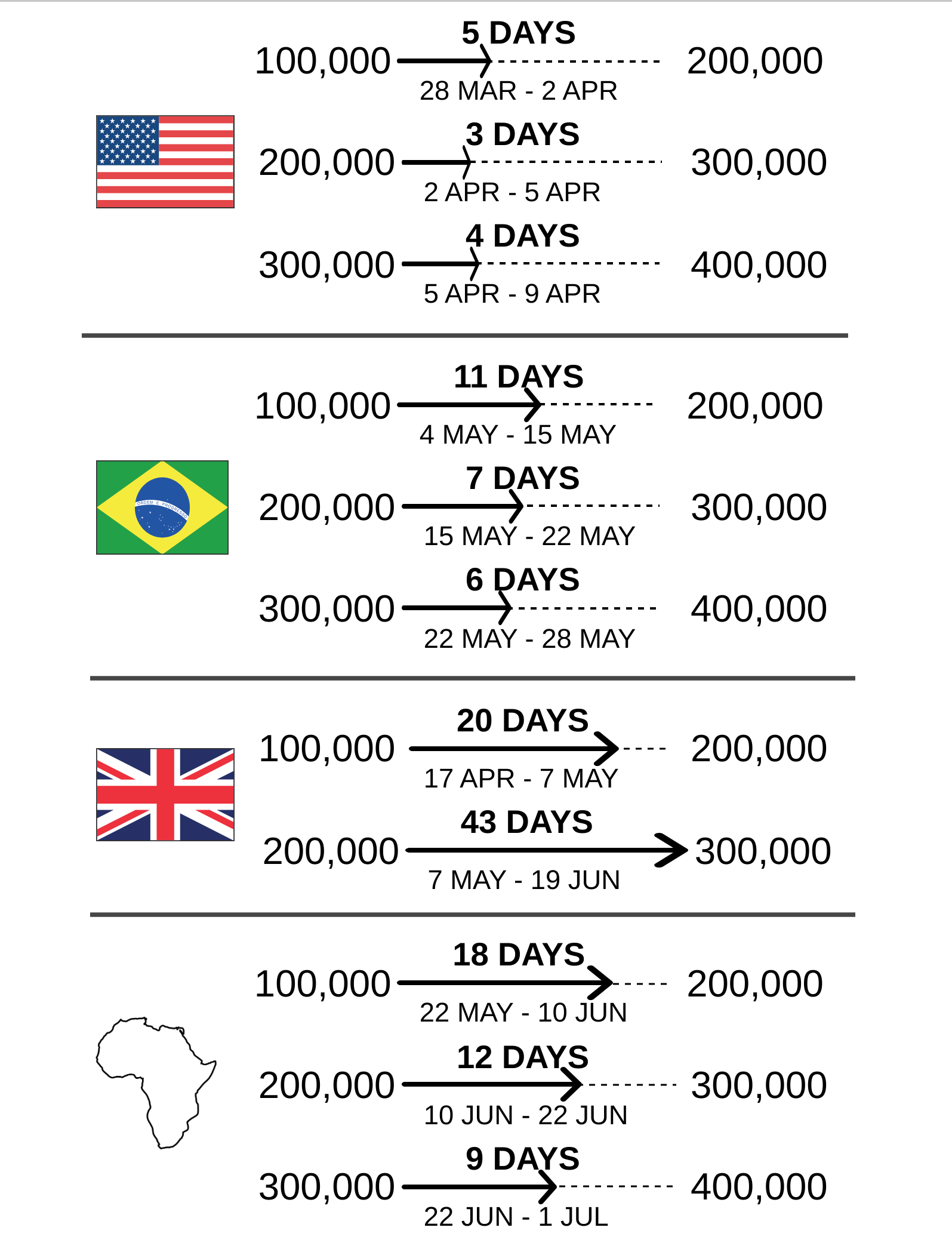Updated Weekly
We have been tracking the spread of COVID19 in African countries for over 4 months now, soon after the first case was recorded in Egypt on 14th February 2020. We have also been tracking the response of African governments to the virus, both in terms of health and economy, as well as development partners, including China.
As we have done so, we have found it interesting to also track the “Africa narratives” set out in some media reporting, and how they have changed over time. Here is a short summary:
- COVID19 will spread like wildfire in Africa (22 February 2020);
- COVID19 is affecting Africa relatively less because so many people are young and the continent is used to dealing with plagues (26 March 2020).
- African countries have too much debt and the weakest health systems – COVID19 will overwhelm them (11 April 2020);
- COVID19 will overwhelm Africa – just slowly, because of lack of transport (16 May 2020);
- The real toll of COVID19 in Africa is other types of deaths (29th May 2020).
- African countries are not testing enough – the problem is much worse than cases indicate (20 June 2020).
In all of these cases, the data we continue to collect shows that the majority of African governments are working to ensure their countries do not appear in these categories, at least not yet, 4 months later. 8 countries account for 74% of the continent’s confirmed cases. In addition, there are definitely some African countries we are concerned about – but for very specific reasons.
Here are the five we are most concerned about and why:
- South Africa is the country with the largest numbers of confirmed and active cases – currently over 75,000, on a curve that does not seem to be flattening as it reaches the levels seen in other countries outside of Africa. Yes, it has also completed the most tests on the continent – accounting for a third of the total (1.7m out of 5.1m tests), but for every 10.5 tests done, 1 case is found. That means South Africa is only just above the 10:1 threshold that WHO recommends countries should be aiming for as a minimum, and is behind 3 other African countries in terms of tests per capita completed… indicating that COVID19 is still not under control.
- Egypt has the 2nd largest number of cases on the continent (around 46,000 active), and while its curve seems to be flattening, it has a poorer test to case ratio than South Africa (5.5:1), and it is opening up to international tourism. We are worried this is premature. More on this below…
- Nigeria is Africa’s most populous country, and third on the continent for cases, but it seems to be testing very little compared to others. On the continent, it is the worst 9th for case:test ratios (for every 5.1 tests done in the country, 1 positive case is found – below the WHO threshold) and also worst 9th for tests per million of the population.
- Sudan is 9th in terms of active cases, which are continuing to rise, and has a fairly high morbidity rate at 6.2%. That means it’s overall 4th for number of deaths, and might indicate health systems are already overwhelmed.
- Tanzania has low numbers of cases, but this may be because a few weeks ago the President suggested COVID19 tests were faulty and the country should open up. As a result, the country has the lowest test per capita ratio on the continent.
Beyond this, the vast majority of African countries are working incredibly hard to test, trace and isolate, as recommended by the Africa CDC and the WHO. 36 African countries are still mandating face-masks in public places, up from 30 a month ago. 30 African countries are meeting the WHO 10:1 testing threshold – with 5 – Botswana, Mauritius, Rwanda, Uganda and Zimbabwe – doing at least 100 tests per case detected.
This means the biggest test now for most African countries is how to keep COVID19 under control and managed as an ongoing issue, while re-opening their economies, carefully.
Some are doing so. So far, ten African countries have now allowed international flights to resume, up from two 2 weeks ago. Of these, perhaps surprisingly, three are within the countries with the top 10 largest numbers of active cases on the continent – Egypt, Ethiopia and Cote D’Ivoire, which is risky for travellers to those countries, but may be seen as necessary in order to revive work, airports and tourism in particular. The others are bearing risk of “importing” cases in order to open up tourism, but most are managing this by ensuring continued social distancing measures internally and clear Standards Of Protocol (SOPs) for various sectors.
We hope these 10 opening countries will remain careful, and that our 5 key concern countries will receive priority health related support from international partners, urgently. For the others, economic support is key, which we will return to next week.
In the meantime, please take a look at our data below, don’t accept the broad narratives without question (check our data as well/instead!), and let us know your reflections and suggestions for further lines of enquiry.

To find out how Development Reimagined can help you, your organisation or Government during the COVID-19 outbreak please email the team at clients@developmentreimagined.com .
Special thanks go to Rosie Wigmore, Rosie Flowers and Jinyu Chen for their work on the graphic and collecting/analysing the underlying data.
The data was collated from a range of sources including: government websites and media reports, the IMF policy tracker; the US Chamber COVID19 Dashboard; Our World in Data, Africa CDC and Worldometer. Our methodology is entirely in-house, based on analysis of social distancing categories and other trends.
If you spot any gaps or have any enquiries, please send your feedback to us at DRteam@developmentreimagined.com, we will aim to respond asap.
July 2020


